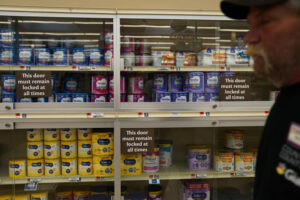SEPTEMBER 13, 2023

The National Retail Federation estimates shrink topped $94 billion in 2021, which would put this year’s figure well north of $100 billion if the rate remains the same or increases. Jahi Chikwendiu/TWP via Getty Images
- A growing number of retailers are blaming retail theft for hurting their profits this year.
- Estimates say inventory shrink will exceed $100 billion for 2023, with over a third due to external theft.
- But a CNBC analysis found losses from retail crime “pale in comparison to other factors.”
In a year that has seen high-profile incidents like “flash robs,” smash-and-grabs, arson, and other brazen crimes capture headlines, corporate earnings calls – especially in the last quarter – have had an increasingly common theme: shrink.
Inventory shrink is an accounting term that refers to several reasons merch goes missing, including damage, managerial errors, and, most conspicuously, theft.
The National Retail Federation estimates shrink topped $94 billion in 2021, which would put this year’s figure well north of $100 billion if the rate remains the same or increases.
Although it gets a lot of attention, shrink is just one of many factors stealing some of the shine from otherwise decent top-line sales numbers. And in many cases, it’s far from the largest.
External theft is responsible for more than a third of overall shrink, and several executives have been quick to blame an increase in crime for lackluster profit margins this summer.
But after almost a year of raising the alarm about the financial impact of shoplifting and organized retail theft, the industry’s claims are undergoing fresh scrutiny.
CNBC counted nearly two dozen retailers that said in recent weeks that shrink is weighing on this year’s earnings. The outlet took a closer look at seven of them: Lowe’s, Target, Macy’s, Dick’s Sporting Goods, TJX, Ulta, and Dollar Tree.
The outlet examined financial statements and other public records to estimate the level of shrink for each and compared it to other merchandising factors that also lead to slimmer profit margins, such as discounts and promotions, excess inventory liquidation, or weather-related damages.
Shrink represents the amount required to square the expected level of inventory a company has on its books with the actual value of the merchandise it has throughout its stores and warehouses, and is most accurately verified with a physical count.
That’s a lot of work, so many companies and analysts often use a historical benchmark rate of about 1% to 1.4% of total sales.
Merchandising decisions can have a bigger impact on profit than retail theft
Lowe’s lost nearly $1 billion to inventory shrink last year, CNBC estimated, with the company noting losses of “live goods damaged by unseasonable weather” that represented about half of the increase from the year before.
As a percentage of sales, shrink reached its highest level in years at 1.03% — nearly double the low of 0.57% in 2016 — but that still leaves the home improvement giant on the lower end of the industry norm.
Target made headlines when CEO Brian Cornell said his company would see over $1.2 billion in shrink this year, up from $753 million in 2022.
But even that increased figure is a third of the $3.66 billion in losses CNBC tallied for Target’s merchandising moves in 2022 including promotions, markdowns, and clearances, as well as higher merchandise and freight costs.
Of course, Cornell and other CEO’s have stated clearly that safety concerns significantly outweigh the financial impact of the recent uptick in retail crime.
Dick’s Sporting Goods cited an “alarming” rise in retail crime as responsible for one-third of the decline in merchandise profits for the last quarter. CFO Navdeep Gupta said the surprisingly high inventory losses were discovered as a result of the company’s annual inventory audit.
Meanwhile CNBC estimates second-quarter shrink of $27.1 million was just half as large as the hit Dick’s took from a $54.8 million inventory liquidation during that period.
The outlet goes into further detail with other retailers, but the story is largely similar: inventory shrink in general — and retail crime in particular — received a disproportionate share of attention in earnings calls (and media coverage) relative to other managerial and operational factors that had a larger impact on profits.

































































































